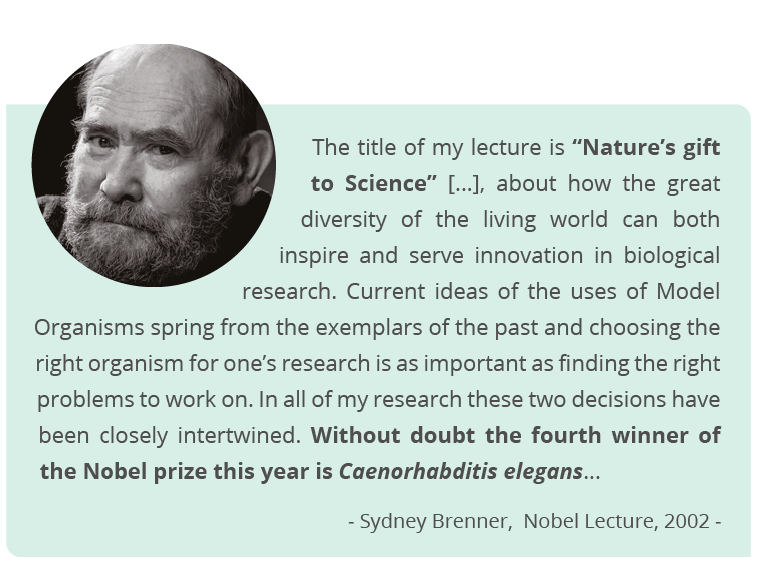
Can C. elegans hear? Nematodes for auditory neuroscience research. Last Friday we published a new #ResearchAlert in our Social Media channels about a ground-breaking discovery from Oregon Health & Science University (OSHU) scientists. The researchers uncovered the missing piece of our inner ear responsible for human hearing. And you guess it right, they used C. elegans worms as a model organism. However, can they hear?
The answer: Yes, but no, but still yes
They do, but not as we may think. Researchers from the University of Michigan Life Science Institute published a paper in 2021 where they observed for the first time that worms are reactive to sound, but instead of through an ear (which they don’t have) they can hear through their skin.
Originally, C. elegans were thought to possess only the senses of touch, smell and taste. However, this research group started to dig into the possibility of C. elegans having other senses and the research was certainly fruitful.
They confirmed that those nematodes also have the capacity to sense light despite not having eyes, as well as proprioception (the ability to sense your own body while moving).


However, this belief was about to change. They found out that worms react to airborne sounds and react to it moving away from the source of the sound. After dismissing the possibility of vibration perception rather than sound itself, the researchers discovered how this was possible.
C. elegans’ whole skin, in fact, acts as an ear. When the sound waves touch their skin, said vibration makes their internal fluids vibrate as well, acting as when fluid vibrates in our cochlea.
And this is not a tiny discovery. The study put on the table the possibility that other organisms that were thought to not perceive sound, in fact, might possess the hearing sense despite lacking ears.
Open the research gates: C. elegans and auditory neuroscience research
The discovery that C. elegans have all primary senses opened new research lines and possibilities in sensory biology. And a clear example is the study of the neuronal mechanisms related to the sense of hearing.
The new research conducted at OSHU published last week in Nature discovered for the first time the missing key of the inner ear that allows humans to hear. The answer? The exact composition of the protein 1 (TMC1) complex. The model organism used? Of course it’s our favorite nematode C. elegans.
Not so much insights about mechanosensory transduction. Until now…
Hearing and balance in mammals is based on what is known as the sensory transduction pathway, which is basically the force transformation happening at the gating of a mechanosensory transduction channel.
The researchers explain in the paper the lack of understanding about the composition, structure and mechanism of the mechanosensory transduction complex, which was the focus of their research efforts.
And the efforts finally got rewarded. They isolated the final molecular mechanism responsible for transforming vibration into sounds, known as mechanosensory transduction complex, opening the possibility of future advances in the auditory neuroscience field that were not imaginable before.
C. elegans: Why this particular model?
You may wonder, why did the authors choose C. elegans as the organism model to work with?
Well, at the beginning of this blog we briefly covered the topic about their capacity to hear and in other posts we also talked about how these tiny roundworms were considered the “NAture GIft to science” (you saw what we did there, isn’t it?).
But what about the specific reasons for this research? The authors wrote:
“To surmount challenges with vertebrate MT complex availability, we turned to C. elegans, an animal that utilizes a MT complex for sensing tactile stimuli. We note first that C. elegans expresses crucial components of the vertebrate MT complex, including the TMC-1 and TMC-2 proteins, in addition to a CIB2 homologue known as CALM-1, as well as TMIE. Second, worms that do not have TMC-1 exhibit attenuated light touch responses. Third, despite the limited expression of the TMC proteins in C. elegans, it is feasible to grow a sufficient number of worms to isolate enough complex for structural studies.”
SydLab One: A full end-to-end C. elegans lab in just a benchtop device
You may wonder now if working with C. elegans is made for you and your research. While worm handling, counting and monitoring may be an arduous task requiring expertise time and materials, Nagi offers an alternative.
SydLab One is an all-in-one solution for high-content screening of drugs and chemicals on small organisms with active flow control. As simple as that. As complete as it sounds.






